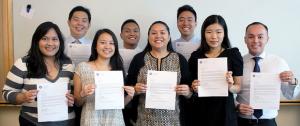Students from underserved areas are accepted into the UH medical school Class of 2020
University of Hawaiʻi at MānoaThe first students to be accepted into the University of Hawai’i's MD Class of 2020 earned their admission letters in the hardest, most fulfilling way possible: by completing the rigorous curriculum of the ʻImi Hoʻōla (“Those Who Seek to Heal”) Post-Baccalaureate Program.
The ʻImi program recruits applicants from socially and economically disadvantaged backgrounds or communities, and the first slots in the upcoming MD class are reserved for those who complete the program.
Tonight, they celebrate with their families in the Medical Education Building Auditorium at the John A. Burns of Medicine, beginning at 5:30 p.m. They are:
- Gavin Ha of Honolulu, a graduate of Roosevelt High in Honolulu and Washington State University (Biochemistry).
- Carrie Ip of Keaʻau on Hawaiʻi Island, a graduate of Waiākea High in Hilo and the University of Hawaiʻi at Hilo (Biology).
- Christina Kawai of ʻAiea, a graduate of ʻAiea High and UH Mānoa (Molecular Cell Biology).
- Eddy Leung of Honolulu, a graduate of Kaiser High and UH Mānoa (Molecular Cell Biology).
- Jaymes Lonzanida of Pearl City, a graduate of Pearl City High and UH Mānoa (Microbiology/Bacteriology).
- Leilani Mangilcmot of Waipahū, a graduate of Waipahū High, UH Mānoa (Biology) and Johns Hopkins University (MS, Molecular Biology).
- Britney Quibelan of ʻAiea, a graduate of Santa Teresa High in San Jose and UH Mānoa (Biology, Women's Studies).
- Keith Sablan of Guam, a graduate of Notre Dame High in Guam and the University of Guam (Biology).
They will meet their classmates in the MD Class of 2020 in mid-July, when all 70 members of the incoming class begin their studies.
About ʻImi Hoʻōla
The program, in its 43rd year, selects up to 12 participants per year from socially and economically disadvantaged backgrounds or communities, including rural towns in Hawaiʻi and the Pacific. Those selected have the opportunity to earn admission to the University of Hawaiʻi medical school through a challenging one-year experience. They are able to focus solely on their learning through generous stipends provided by The Queen's Health Systems. Graduates of the ʻImi program have gone on to earn their JABSOM degrees and achieve great success. Alumni include Gerard Akaka, MD, Chief Medical Officer and Vice President of The Queen’s Medical Center; Naleen Andrade, MD, the first woman psychiatrist of Native Hawaiian descent in Hawaiʻi who is now the Designated Institutional Officer of JABSOM’s Graduate Medical Education; Chiyome Fukino, MD, former Hawaiʻi State Director of Health, and many physicians who are helping provide top-notch care to communities throughout Hawaiʻi.
ʻImi is not limited to students of Native Hawaiian ancestry, but many have been, along with students of Filipino, Chamorro, Micronesian and Samoan ancestry. So far, the program has successfully nurtured more than 250 MDs -- about 40% of them physicians of Native Hawaiian ancestry. A majority of the ʻImi graduates practice medicine in underserved communities when they complete their MD and MD graduate medical (“residency training”) education.
Link to downloadable photograph: https://www.flickr.com/photos/uhmed/27601110681/in/album-72157667103489093/
(Full photo caption) Members of the ʻImi Hoʻōla 2015-2016 Class hold their acceptance letters into UH medical school. They are, from left, Leilani Manglicmot, Gavin Ha, Carrie Ip, Jaymes Lonzanida, Britney Quibelan, Eddy Leung, Christina Kawai and Keith Sablan.
For more information, visit: http://jabsom.hawaii.edu/news-media/uh-med-now/

